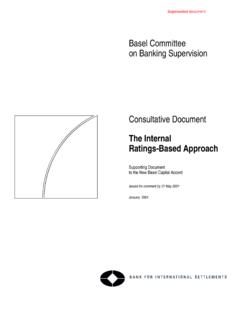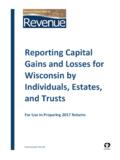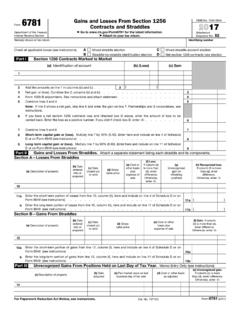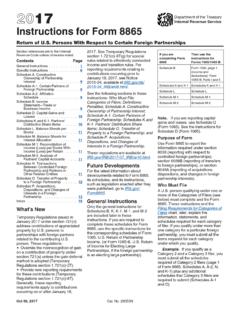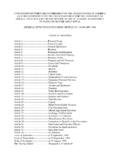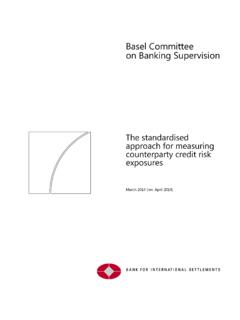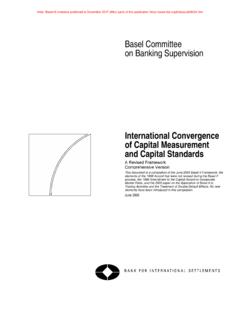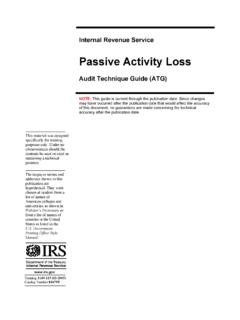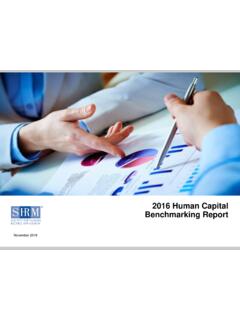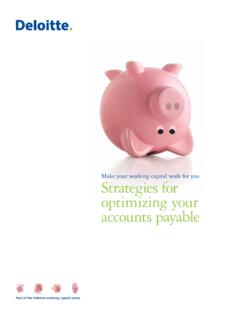Transcription of 2020 Form 4972 - Internal Revenue Service
1 Form 4972 Department of the Treasury Internal Revenue Service (99) Tax on Lump-Sum Distributions (From Qualified Plans of Participants Born Before January 2, 1936) Go to for the latest information. Attach to Form 1040, Form 1040NR, or Form No. 1545-01932018 Attachment Sequence No. 28 Name of recipient of distributionIdentifying numberPart IComplete this part to see if you can use Form 49721 Was this a distribution of a plan participant s entire balance (excluding deductible voluntary employee contributions and certain forfeited amounts) from all of an employer s qualified plans of one kind (for example, pension, profit-sharing, or stock bonus)? If No, don t use this form ..YesNo1 2 Did you roll over any part of the distribution? If Yes, don t use this form ..2 3 Was this distribution paid to you as a beneficiary of a plan participant who was born before January 2, 1936?
2 3 4 Were you (a) a plan participant who received this distribution, (b) born before January 2, 1936, and (c) a participant in the plan for at least 5 years before the year of the distribution? ..4 If you answered No to both questions 3 and 4, don t use this a Did you use Form 4972 after 1986 for a previous distribution from your own plan? If Yes, don t use this form for a 2018 distribution from your own plan ..5a b If you are receiving this distribution as a beneficiary of a plan participant who died, did you use Form 4972 for a previous distribution received as a beneficiary of that participant after 1986? If Yes, don t use thisform for this distribution ..5bPart IIComplete this part to choose the 20% capital gain election (see instructions)6 capital gain part from Form 1099-R, box 3 ..6 7 Multiply line 6 by 20% ( ) .. 7 If you also choose to use Part III, go to line 8.
3 Otherwise, include the amount from line 7 in thetotal on Form 1040, line 11; Form 1040NR, line 42; or Form 1041, Schedule G, line 1b. Be sure to check box 2 on Form 1040, line 11, or check box b on Form 1040NR, line IIIC omplete this part to choose the 10-year tax option (see instructions)8 If you completed Part II, enter the amount from Form 1099-R, box 2a, minus box 3. If you didn t complete Part II, enter the amount from box 2a. Multiple recipients (and recipients who elect to include net unrealized appreciation (NUA) in taxable income), see 9 Death benefit exclusion for a beneficiary of a plan participant who died before August 21, 1996 .9 10 Total taxable amount. Subtract line 9 from line 8 ..10 11 Current actuarial value of annuity from Form 1099-R, box 8. If none, enter -0- ..11 12 Adjusted total taxable amount. Add lines 10 and 11.
4 If this amount is $70,000 or more, skip lines13 through 16, enter this amount on line 17, and go to line 18 ..12 13 Multiply line 12 by 50% ( ), but don t enter more than $10,000 ..13 14 Subtract $20,000 from line 12. If line 12 is $20,000 or less, enter -0- ..14 15 Multiply line 14 by 20% ( ) ..15 16 Minimum distribution allowance. Subtract line 15 from line 13 ..16 17 Subtract line 16 from line 12 ..17 18 Federal estate tax attributable to lump-sum distribution ..18 19 Subtract line 18 from line 17. If line 11 is zero, skip lines 20 through 22 and go to line 23 ..19 20 Divide line 11 by line 12 and enter the result as a decimal (rounded to at least three places) ..20 .21 Multiply line 16 by the decimal on line 20 ..21 22 Subtract line 21 from line 11 ..22 23 Multiply line 19 by 10% ( ) ..23 24 Tax on amount on line 23. Use the Tax Rate Schedule in the instructions.
5 24 25 Multiply line 24 by If line 11 is zero, skip lines 26 through 28, enter this amount on line 29, and go to line 30 ..25 26 Multiply line 22 by 10% ( ) ..26 27 Tax on amount on line 26. Use the Tax Rate Schedule in the instructions ..27 28 Multiply line 27 by ..28 29 Subtract line 28 from line 25. Multiple recipients, see instructions .. 29 30 Tax on lump-sum distribution. Add lines 7 and 29. Also include this amount in the total on Form 1040, line 11 (check box 2); Form 1040NR, line 42 (check box b); or Form 1041, Schedule G, line 1b .. 30 For Paperwork Reduction Act Notice, see No. 13187 UForm 4972 (2018)Form 4972 (2018)Page 2 Section references are to the Internal Revenue developments. For the latest information about developments related to Form 4972 and its instructions, such as legislation enacted after they were published, go to InstructionsPurpose of FormUse Form 4972 to figure the tax on a qualified lump-sum distribution (defined below) you received in 2018 using the 20% capital gain election, the 10-year tax option, or both.
6 These are special formulas used to figure a separate tax on the distribution that may result in a smaller tax than if you reported the taxable amount of the distribution as ordinary pay the tax only once, for the year you receive the distribution, not over the next 10 years. The separate tax is added to the regular tax figured on your other PublicationsFor more information related to this topic, see the following publications. Pub. 575, Pension and Annuity Income. Pub. 721, Tax Guide to Civil Service Retirement Benefits. Pub. 939, General Rule for Pensions and Is a Qualified Lump-Sum Distribution?It is the distribution or payment in one tax year of a plan participant s entire balance from all of an employer s qualified plans of one kind (for example, pension, profit-sharing, or stock bonus plans) in which the participant had funds.
7 The participant s entire balance doesn t include deductible voluntary employee contributions or certain forfeited amounts. The participant must have been born before January 2, upon death of the plan participant. If you received a qualified distribution as a beneficiary after the participant s death, the participant must have been born before January 2, 1936, for you to use this form for that to alternate payees. If you are the spouse or former spouse of a plan participant who was born before January 2, 1936, and you received a qualified lump-sum distribution as an alternate payee under a qualified domestic relations order, you can use Form 4972 to figure the tax on the distribution using the 20% capital gain election, the 10-year tax option, or both. For details, see Pub. That Don t Qualify for the 20% capital Gain Election or the 10-Year Tax OptionThe following distributions aren t qualified lump-sum distributions and don t qualify for the 20% capital gain election or the 10-year tax option.
8 The part of a distribution not rolled over if the distribution is partially rolled over to another qualified plan or an IRA. Any distribution if an earlier election to use either the 5- or 10-year tax option had been made after 1986 for the same plan participant. Retirement Plan Bonds distributed with the lump sum. A distribution made during the first 5 tax years that the participant was in the plan, unless it was made because the participant died. The current actuarial value of any annuity contract included in the lump sum (Form 1099-R, box 8, should show this amount, which you use only to figure tax on the ordinary income part of the distribution). A distribution to a 5% owner that is subject to penalties under section 72(m)(5)(A). A distribution from an IRA. A distribution from a tax-sheltered annuity (section 403(b) plan). A distribution of the redemption proceeds of bonds rolled over tax free to a qualified pension plan, etc.
9 , from a qualified bond purchase plan. A distribution from a qualified plan if the participant or his or her surviving spouse previously received an eligible rollover distribution from the same plan (or another plan of the employer that must be combined with that plan for the lump-sum distribution rules) and the previous distribution was rolled over tax free to another qualified plan or an IRA. A distribution from a qualified plan that received a rollover after 2001 from an IRA (other than a conduit IRA), a governmental section 457(b) plan, or a section 403(b) tax-sheltered annuity on behalf of the plan participant. A distribution from a qualified plan that received a rollover after 2001 from another qualified plan on behalf of that plan participant s surviving spouse. A corrective distribution of excess deferrals, excess contributions, excess aggregate contributions, or excess annual additions.
10 A lump-sum credit or payment under the alternative annuity option from the Federal Civil Service Retirement System (or the Federal Employees Retirement System).How To Report the DistributionIf you can use Form 4972, attach it to Form 1040 (individuals), Form 1040NR (nonresident aliens), or Form 1041 (estates or trusts). The payer should have given you a Form 1099-R or other statement that shows the amounts needed to complete Form 4972. The following choices are capital gain election. If there is an amount in Form 1099-R, box 3, you can use Form 4972, Part II, to apply a 20% tax rate to the capital gain portion. See capital Gain Election, tax option. You can use Part III to figure your tax on the lump-sum distribution using the 10-year tax option whether or not you make the 20% capital gain amount. If Form 1099-R, box 2a, is blank, you must figure the taxable amount to complete Form 4972.










